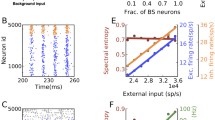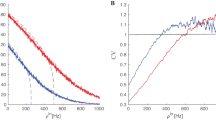Abstract
Medial entorhinal cortex layer II stellate cells display subthreshold oscillations (STOs). We study a single compartment biophysical model of such cells which qualitatively reproduces these STOs. We argue that in the subthreshold interval (STI) the seven-dimensional model can be reduced to a three-dimensional system of equations with well differentiated times scales. Using dynamical systems arguments we provide a mechanism for generations of STOs. This mechanism is based on the “canard structure,” in which relevant trajectories stay close to repelling manifolds for a significant interval of time. We also show that the transition from subthreshold oscillatory activity to spiking (“canard explosion”) is controlled in the STI by the same structure. A similar mechanism is invoked to explain why noise increases the robustness of the STO regime. Taking advantage of the reduction of the dimensionality of the full stellate cell system, we propose a nonlinear artificially spiking (NAS) model in which the STI reduced system is supplemented with a threshold for spiking and a reset voltage. We show that the synchronization properties in networks made up of the NAS cells are similar to those of networks using the full stellate cell models.
Similar content being viewed by others
References
Acker CD, Kopell N, White JA (2003) Synchronization of strongly coupled excitatory neurons: Relating network behavior to biophysics. J. Comput. Neurosci. 15: 71–90.
Alonso AA, García Austt E (1987) Neuronal sources of theta rhythm in the entorhinal cortex of the rat. II. Phase relations between unit discharges and theta field potentials. Exp. Brain Res. 67: 493–501.
Alonso AA, Klink R (1993) Differential electroresponsiveness of stellate and pyramidal-like cells of medial entorhinal cortex layer II. J. Neurophysiol. 70: 144–157.
Alonso AA, Llinás RR (1989) Subthreshold Na+-dependent theta like rhythmicity in stellate cells of entorhinal cortex layer II. Nature 342: 175–177.
Baer SM, Erneux T, Rinzel J (1989) The slow passage through a Hopf bifurcation: delay, memory effects, and resonance. SIAM J. Appl. Math. 49: 55–71.
Benoit E, Callot JL, Dienner F, MD (1980) Chasse au Canard. IRMA, Strasbourg.
Brons M, Krupa M, Wechselberger M (2005) Mixed mode oscillations due to the generalized canard phenomenon. Submitted.
Burden RL, Faires JD (1980) Numerical Analysis. PWS Publishing Company, Boston.
Buzsáki G (1989) Two-stage model of memory trace formation: A role for ‘noisy’ brain states. Neuroscience 31: 551–570.
Buzsáki G, Draguhn (2004) Neuronal oscillations in cortical networks. Science 304: 1926–1929.
Chow CC, White JA (1996) Spontaneous action potentials due to channel fluctuation. Bioph. J. 71: 3013–3021.
Clewley R, Rotstein HG, Kopell N (2005) A computational tool for the reduction of nonlinear ode systems possening multiple scales. SIAM J. Multiscale Model. Sim. (in press).
Dayan P, Abbott LF (2001) Theoretical Neuroscience. The MIT Press.
Destexhe A, Mainen ZF, Sejnowski TJ (1994) Synthesis of models for excitable membranes, synaptic transmission and neuromodulation using a common kinetic formalism 3: 195–230.
Dickson CT, Magistretti J, Shalinsky M, Hamam B, Alonso AA (2000a) Oscillatory activity in entorhinal neurons and circuits. Ann. NY Acad. Sci. 911: 127–150.
Dickson CT, Magistretti J, Shalinsky MH, Fransén E, Hasselmo M, Alonso AA (2000b) Properties and role of I h in the pacing of subthreshold oscillation in entorhinal cortex layer II neurons. J. Neurophysiol. 83: 2562–2579.
Drover J, Rubin J, Su J, Ermentrout B (2004) Analysis of a canard mechanism by which excitatory synaptic coupling can synchronize neurons at low firing frequencies. SIAM J. Appl. Math. 65: 69–92.
Dumortier F, Roussarie R (1996) Canard cycles and center manifolds. Mem. Am. Math. Soc. 121 (577).
Eckhaus W (1983) Relaxation oscillations including a standard chase on french ducks. In Lecture Notes in Mathematics, Springer-Verlag 985: 449–497.
Erchova I, Kreck G, Heinemann U, Herz AVM (2004) Dynamics of rat entorhinal cortex layer II and III cells: characteristics of membrane potential resonance ar rest predict oscillation properties near threshold. J. Physiol. 560: 89–110.
Fenichel N (1971) Persistence and smoothness of invariant manifolds for flows. Ind. Univ. Math. J. 21: 193–225.
Fransén E, Alonso AA, Dickson CT, Magistretti J, Hasselmo ME (2004) Ionic mechanisms in the generation of subthreshold oscillations and action potential clustering in entorhinal layer II stellate neurons. Hippocampus 14: 368–384.
Fransén E, Dickson CT, Magistretti J, Alonso AA, Hasselmo ME (1998) Modeling the generation of subthreshold membrane potential oscillations of entorhinal cortex layer II stellate cells. Soc. Neurosci. Abstr. 24: 814–815.
Fransén E, Wallestein GV, Alonso AA, Dickson CT, Hasselmo ME (1999) A biophysical simulation of intrinsic and network properties of entorhinal cortex. Neurocomputing 26–27: 375–380
Gillies MJ, Traub RD, LeBeau FEN, Davies CH, Gloveli T, Buhl EH, Whittington MA (2002) A model of atropine-resistant theta oscillations in rat hippocampal area CA1. J. Physiol. 543.3: 779–793.
Hutcheon B, Miura RM, Puil E (1996) Subthreshold membrane resonance in neocortical neurons. J. Neurophysiol. 76: 683–697.
Hutcheon B, Yarom Y (2000) Resonance oscillations and the intrinsic frequency preferences in neurons. Trends Neurosci. 23: 216–222.
Izhikevich E (2005) Dynamical Systems in Neuroscience. (http://www.nsi.edu/users/izhikevich/publications/index.htm), Section 5.1.4. MIT Press.
Izhikevich EM (2001) Resonate-and-fire neurons. Neural Netw. 14: 883–894.
Jalics J, Kispersky T, Dickson C, Kopell N (2004) Neuronal ensembles and modules: Modeling dynamics in medial entorhinal cortex. Soc. Neurosci. Abstr. 517.1.
Jalics J, Rotstein HG, Kopell N (2005) Unpublished data.
Kahana MJ, Sekuler R, Caplan JB, Kirschen M, Madsen JR (1999) Human theta oscillations exhibit task dependence during virtual maze navigation. Nature 399: 781–784.
Klink RM, Alonso A (1993) Ionic mechanisms for the subthreshold oscillations and differential electroresponsiveness of medial entorhinal cortex layer II neurons. J. Neurophysiol. 70: 128–143.
Klink RM, Alonso AA (1997) Ionic mechanisms of muscarinic depolarization in entorhinal cortex layer II neurons. J. Neurophysiol. 77: 1829–1843.
Koch C (1999) Biophysics of Computation. Oxford University Press.
Kopell N, LeMasson G (1994) Rhythmogenesis, amplitude modulation, and multiplexing in a cortical architecture. Proc. Natl. Acad. Sci. USA 91: 10586–10590.
Krupa M, Szmolyan P (2001) Relaxation oscillation and canard explosion. J. Diff. Eq. 174: 312–368.
Llinás RR, Yarom Y (1981) Electrophysiology of mammalian inferior olivary neurons in vitro different types of voltage-dependent ionic conductances. J. Physiol. 315: 549–567.
Llinás RR, Yarom Y (1986) Oscillatory properties of guinea pig olivary neurons and their pharmachological modulation: An in vitro study. J. Physiol. 376: 163–182.
Magistretti J, Alonso AA (1999) Biophysical properties and slow valtage-dependent inactivation of a sustained sodium current in entorhinal cortex layer-II principal neurons. a whole-cell and single-channel study. J. Gen. Physiol. 114(4): 491–509.
Magistretti J, Ragsdale DS (1999) High conductance sustained single-channel activity responsible for the low-threshold persistent Na+ current in entorhinal cortex neurons. J. Neurosci. 19(17): 7334–7341.
Makarov VA, Nekorkin VI, Velarde MG (2001) Spiking behavior in a noise-driven system combining oscillatory and excitatory properties. Phys. Rev. Lett. 15: 3031–3034.
Neishtadt AI (1987) Persistence of stability loss for dynamical bifurcations I. Diff. Eqs. 23: 1385–1391.
Neishtadt AI (1988) Persistence of stability loss for dynamical bifurcations II. Diff. Eqs. 24: 171–176.
Netoff T, Banks M, White J (2003) Bridging single cell and network dynamics. Soc. Neurosci. Abstr. 32: 171.7.
Netoff T, Pervouchine D, Kopell N, White J (2004) Oscillation frequency switches in model and hybrid networks of the hippocampus. Soc. Neurosci. Abstr. *32*. In press.
Pervouchine DD, Netoff TI, Rotstein HG, White JA, Kopell N (2005) Low-dimensional maps encoding dynamics in entorhinal cortex and hippocampus. In revision.
Richardson MJE, Brunel N, Hakim V (2003) From subthreshold to firing-rate resonance. J. Neurophysiol. 89: 2538–2554.
Rinzel J (1985) Excitation dynamics: Insights from simplified membrane models. Fed. Proc. 44: 2944–2946.
Rotstein HG, Clewley R, Wechselberger M, Kopell N (2005a) Reduction of dimensions and dynamics of a medial entorhinal cortex layer II stellate cell model. In preparation.
Rotstein HG, Pervouchine D, Gillies MJ, Acker CD, White JA, Buhl EH, Whittington MA, Kopell N (2005b) Slow and fast inhibition and h-current interact to create a theta rhythm in a model of CA1 interneuron networks. J. Neurophysiol. 94: 1509–1518.
Schreiber S, Erchova I, Heinemann U, Herz AV (2004) Subthreshold resonance explains the frequency-dependent integration of periodic as well as random stimuli in the entorhinal cortex. J. Neurophysiol. 92: 408–415.
Shalinsky JH, Magistretti J, Ma L, Alonso AA (2002) Muscarinic activation of a cation current and associated current noise in entorhinal-cortex layer-II neurons. J. Neurophysiol. 88: 1197–1211.
Spain WJ, Schwindt PC, Crill WE (1987) Anomalous rectification in neurons from cat sensorimotor cortex in vitro. J. Neurophysiol. 57: 1555–1576.
Szmolyan P, Wechselberger M (2001) Canards in R 3. J. Diff. Eq. 177: 419–453.
Wechselberger M (2005) Existence and bifurcation of canards in R 3 in the case of a folded node. SIAM J. Appl. Dyn. Syst. 4: 101–139.
White JA, Budde T, Kay ARA (1995) A bifurcation analysis of neuronal subthreshold oscillations. Biophysical. J. 69: 1203–1217.
White JA, Klink R, Alonso A, Kay ARA (1998) Noise from voltage-gated ion channels may influence neuronal dynamics in the entorhinal cortex. J. Neurophysiol. 80: 262–269.
White JA, Rubinstein JT, Kay AA (2000) Channel noise in neurons. Trends Neurosci. 23(3): 131–137.
Winson J (1978) Loss of hippocampal theta rhythm results in spatial memory deficit in the rat. Science 201: 160–163.
Author information
Authors and Affiliations
Additional information
In memory of Angel A. Alonso
Rights and permissions
About this article
Cite this article
Rotstein, H.G., Oppermann, T., White, J.A. et al. The dynamic structure underlying subthreshold oscillatory activity and the onset of spikes in a model of medial entorhinal cortex stellate cells. J Comput Neurosci 21, 271–292 (2006). https://doi.org/10.1007/s10827-006-8096-8
Received:
Revised:
Accepted:
Published:
Issue Date:
DOI: https://doi.org/10.1007/s10827-006-8096-8




